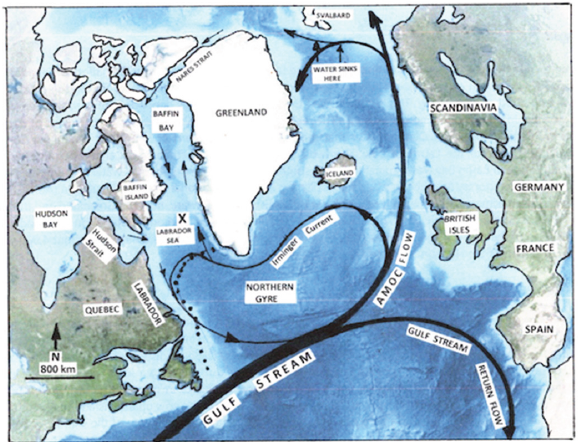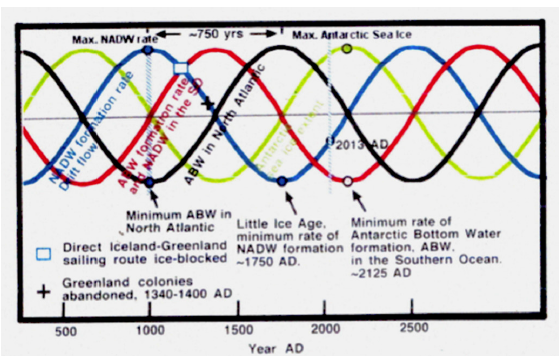- Submissions

Full Text
Examines in Marine Biology & Oceanography
The Cause of the Little Ice Age and Why Southern Greenland Became Colder than Iceland
Robert G Johnson*
Earth Sciences Department, University of Minnesota, USA
*Corresponding author: Robert G Johnson, Earth Sciences Department, University of Minnesota, USA
Submission: March 25, 2023;Published: April 20, 2023

ISSN 2578-031X Volume5 Issue5
Abstract
The cause of the Little Ice Age was the reduction of northward flow of warmer Gulf Stream water west of Europe. This flow contributes to the Northern Gyre, which warms first Iceland and then Greenland. The flow reduction was caused by a 1500-year cyclic increase of lower salinity Antarctic bottom water that upwells and enters the high latitude North Atlantic and tends to reduce intermediate level deep water formation. This feedback increase of bottom water flow is produced cyclically by enhanced freezing over the Antarctic continental shelf. This occurs with a delayed increase of somewhat warmer and more saline intermediate level water from the North arrives in the Southern Ocean and minimizes the sea ice over the continental shelf and its insulating effect from the cold atmosphere.
Introduction
The climate cooling of The Little Ice Age during the present interglacial climate interval was most severe in the land areas around the higher latitudes of the North Atlantic Ocean. Historical records tell us that, with lower winter temperatures, canals in the Netherlands froze over, crops failed in the British Isles, and the sea surface between Staten Island and Manhattan also froze over. The cold winter suffering of Washington’s revolutionary army at Valley Forge is a well-known fact.
The Superficial Cause of the Little Ice Age
The obvious cause was the reduced rate of northward flow of warmer Gulf Stream water off the western coast of Europe. That salty flow, often called the North Atlantic Drift, is largely driven by the need to replace the salty surface water that becomes denser and sinks northeast of Greenland. That northward flow divides into two main oceanic flows, (Figure 1). One goes northward, and part of it sinks to the mid-depths northeast of Greenland when it cools and becomes denser in winter. The other goes westward at a lower latitude carrying somewhat warmer Gulf Stream water to Iceland and then to southern Greenland. That flow is the northern part of the large Northern Gyre. Its return flow towards the east borders the eastward arm of the Gulf Stream. Iceland also became colder during the Little Ice Age, but Iceland was closer to the source of warm Gulf Stream water than was Greenland and was less affected by the flow reduction of warm Gulf Stream water into the Northern Gyre. Therefore, although Iceland sometimes became surrounded by winter sea ice, it did not become as cold as in Greenland. And unlike Greenland, the Norse living in Iceland were not forced to abandon their homes. On the western side of the North Atlantic the cooling of the Northern Gyre caused colder winters as far south as New England and the New York areas [1].
The Cause Underlying the Reduction of Northward Gulf Stream Flow West of Europe
That northward flow rate of surface water from the Gulf Stream off Europe, depends largely on its winter sinking rate when it cools northeast of Greenland, and this depends on how much more saline and more dense it is than the underlying high latitude water. This difference in saltiness depends primarily on the fact that tropical evaporation has made the original Gulf Stream water more saline than high latitude oceanic water below the surface. But after the Gulf Stream water branches off northward as shown in Figure 1, its salinity can be altered by other factors, which are:
Figure 1:Shows the branching of northward Gulf Stream flow that sends warmer water toward Iceland and Southern Greenland, and water that cools and sinks at the higher latitude Northeast of Greenland.

a) Mediterranean outflow from the strait of Gibraltar: This water today has at least 2ppmil greater salinity than Atlantic water. It mixes into Atlantic water and significantly increases its salinity.
b) Antarctic bottom water: This is quite cold water, with lower salinity than North Atlantic water, and is produced by salt rejection when shallower water freezes over the Antarctic continental shelves. Westward trade winds cause this widely distributed bottom water to up well off the West African coast. From there it mixes into the northward flow of Gulf Stream water west of Europe, and its lower salinity diminishes the rate of high latitude sinking. It is therefore the negative salinity factor of Antarctic Bottom Water that depressed high latitude northward Gulf Stream flow and caused the little ice Age. Antarctic Bottom Water production is part of a feedback loop that tends to diminish the rate of surface water sinking northeast of Greenland. This loop (Figure 2) occurs because the water sinking northeast of Greenland only goes to the mid-depths. There it accumulates and moves southward as described by Walley Broecker. When it reaches the ocean around Antarctica, it mixes upward, and its somewhat greater warmth and salinity tends to prevent thick sea ice accumulation over the Antarctic continental shelves.
Figure 2:Shows one of the feedback loops that, with inter-ocean transport delays, causes the oscillations of the little ice age and the oceanic factors of Figure 3.

Therefore, Antarctic Bottom Water production will be strongly dependent on absence of thicker Antarctic Sea ice. When present, and when covering the large area of shallow water over the Antarctic continental shelf, it greatly diminishes seasonal sea ice freezing. When it is absent, seasonal freezing with salt rejection occurs over a wide area of shallow continental shelf water. The salt rejection creates large volumes of colder and slightly denser water that sink to the deepest levels of the ocean. After a few centuries of world-wide accumulation, this water becomes significantly upwelled by trade wind action off the coast of West Africa. From there it diffuses into the higher latitude North Atlantic. Its lower salinity relative to North Atlantic water diminishes the sinking rate of Northern surface water and the northward flow of Gulf Stream water west of Europe [2].
Summary
Any increase or decrease in the rate of water sinking to middepths northeast of Greenland causes an increase or decrease in the rate of Antarctic bottom water production over Antarctic continental shelves. Any increase or decrease of Antarctic bottom water production causes a decrease or increase of sinking surface water northeast of Greenland. If these two feedbacks were instantaneous, no changes would occur. But delays do occur, and the two continuously opposing feedback effects may therefore result in sinusoidal oscillations of the oceanic factors that cause the changes, as in Figure 3. Consequently, the negative feedback of Antarctic bottom water into the high latitude North Atlantic is the probable cause for the observed interglacial cycle of about 1500 years for the variation of ice-rafted debris in deep-sea sediments west of Europe, and the same likely cycle of Little Ice Age climate [3]. The phase relationships for these oceanic feedback factors are displayed in Figure 3. This cycle is now being profoundly altered by mankind’s construction of dams on the Nile and Eurasian rivers for irrigation that are causing the Mediterranean salinity to increase relatively rapidly.
Figure 3:Shows maxima and minima and phase relationships for climate and oceanic factors that cause the little ice age climate oscillation.

References
- Broecker WS (1991) The great ocean conveyor. Oceanography 4(2): 79-90.
- Bond G, Showers W, Cheseby M, Lotti R, Almasi P, et al. (1997) A pervasive millennial-scale cycle in North Atlantic, Holocene and glacial climates. Science 278: 1257-1266.
- Johnson RG (2015) Did a bi-polar multi-level oceanic oscillation cause the little ice age and other high latitude climate extremes? Journal of Advances in Natural Sciences 3(1): 228-236.
© 2023 Robert G Johnson. This is an open access article distributed under the terms of the Creative Commons Attribution License , which permits unrestricted use, distribution, and build upon your work non-commercially.
 a Creative Commons Attribution 4.0 International License. Based on a work at www.crimsonpublishers.com.
Best viewed in
a Creative Commons Attribution 4.0 International License. Based on a work at www.crimsonpublishers.com.
Best viewed in 







.jpg)






























 Editorial Board Registrations
Editorial Board Registrations Submit your Article
Submit your Article Refer a Friend
Refer a Friend Advertise With Us
Advertise With Us
.jpg)






.jpg)














.bmp)
.jpg)
.png)
.jpg)










.jpg)






.png)

.png)



.png)






